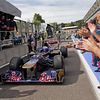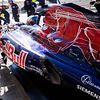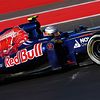Technical analysis of the STR7

Toro Rosso's new STR7 has a tough task for succeed the famous double floor {Toro Rosso STR6}. That car worked particularly well towards the end of the season, once the team worked out how to optimise the blown diffuser. The STR7 though looks set not to disappoint.
The new car has an extremely flat nose, wide and sharp which is nearly 550mm from the ground, the maximum allowed under the current regulations. Toro Rosso appears to be as interested as Ferrari into getting as much air as possible under the nose to increase the downforce potential of the floor and diffuser.
The step is also elegantly solved by creating two bumps on each side of the nosecone. This makes sure that the front bulkhead section is 300mm high, while the middle part is sloping upward more fluently, potentially creating less drag than other solutions.
The front wing looks fairly similar to last year's, but it is expected that either at the beginning of testing, or at the final test in Barcelona, an update will be added to the car. The front wing supports have been lengthened at the top, while the cameras are mounted immediately ahead of the upper front wishbone.
Just like on the STR6, the sidepods have a dramatic undercut over the entire length of the sidepods. It follows the 2011 idea to create sidepods with a small frontal area, allowing for a lot of air to pass around without being diverted a lot. Although the sidepods extend further back to get rid of the cooling air, the solution is an interesting take on the regulations.
In fact, most of the critics on their design last year were about the increased surface of the sidepod which could potentially slow airflow around it due to the boundary layer effect. By reducing some of the undercut on the STR7 in favour of even narrower sidepods at the top, Toro Rosso have likely solved their one weakness with these sidepods.
On top of the car, the airbox has also undergone a major rework, as the engine air intake is now greatly undercut and supported by 2 pillar supports on each side of the intake, immediately behind the cockpit. But instead of using that air for the rear wing, Toro Rosso have added an intake under the main engine intake - similar but more larger and more extended to what Sauber did.
Towards the rear, Toro Rosso positioned the exhausts as far back as they could, exiting out of the sidepod ceiling and aimed at blowing onto the upside of the beam wing, through the rear suspension arms - which continues to be a pull rod set-up.








